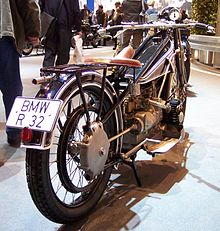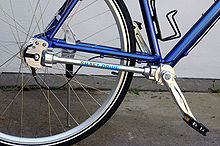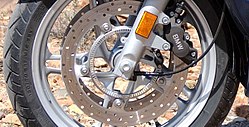| Revision as of 12:48, 13 April 2017 edit209.221.240.193 (talk) →Rsearch and development← Previous edit | Revision as of 07:54, 27 April 2017 edit undoRavi6474 (talk | contribs)4 editsNo edit summaryNext edit → | ||
| Line 8: | Line 8: | ||
| To allow for variations in the alignment and distance between the driving and driven components, drive shafts frequently incorporate one or more ]s, ]s, or ]s, and sometimes a ] or ]. | To allow for variations in the alignment and distance between the driving and driven components, drive shafts frequently incorporate one or more ]s, ]s, or ]s, and sometimes a ] or ]. | ||
| It consists mainly of three parts: | |||
| 1) Shaft | |||
| 2) Universal Joints | |||
| 3) Slip Joint | |||
| ==History== | ==History== | ||
Revision as of 07:54, 27 April 2017


| This article needs additional citations for verification. Please help improve this article by adding citations to reliable sources. Unsourced material may be challenged and removed. Find sources: "Drive shaft" – news · newspapers · books · scholar · JSTOR (June 2010) (Learn how and when to remove this message) |
A drive shaft, driveshaft, driving shaft, propeller shaft (prop shaft), or Cardan shaft is a mechanical component for transmitting torque and rotation, usually used to connect other components of a drive train that cannot be connected directly because of distance or the need to allow for relative movement between them.
As torque carriers, drive shafts are subject to torsion and shear stress, equivalent to the difference between the input torque and the load. They must therefore be strong enough to bear the stress, whilst avoiding too much additional weight as that would in turn increase their inertia.
To allow for variations in the alignment and distance between the driving and driven components, drive shafts frequently incorporate one or more universal joints, jaw couplings, or rag joints, and sometimes a splined joint or prismatic joint. It consists mainly of three parts: 1) Shaft 2) Universal Joints 3) Slip Joint
History
The term drive shaft first appeared during the mid 19th century. In Stover's 1861 patent reissue for a planing and matching machine, the term is used to refer to the belt-driven shaft by which the machine is driven. The term is not used in his original patent. Another early use of the term occurs in the 1861 patent reissue for the Watkins and Bryson horse-drawn mowing machine. Here, the term refers to the shaft transmitting power from the machine's wheels to the gear train that works the cutting mechanism.
In the 1890s, the term began to be used in a manner closer to the modern sense. In 1891, for example, Battles referred to the shaft between the transmission and driving trucks of his Climax locomotive as the drive shaft, and Stillman referred to the shaft linking the crankshaft to the rear axle of his shaft-driven bicycle as a drive shaft. In 1899, Bukey used the term to describe the shaft transmitting power from the wheel to the driven machinery by a universal joint in his Horse-Power. In the same year, Clark described his Marine Velocipede using the term to refer to the gear-driven shaft transmitting power through a universal joint to the propeller shaft. Crompton used the term to refer to the shaft between the transmission of his steam-powered Motor Vehicle of 1903 and the driven axle.
Automotive drive shaft
Vehicles
An automobile may use a longitudinal shaft to deliver power from an engine/transmission to the other end of the vehicle before it goes to the wheels. A pair of short drive shafts is commonly used to send power from a central differential, transmission, or transaxle to the wheels.

Front-engine, rear-wheel drive
Main article: Front-engine, rear-wheel drive layoutIn front-engined, rear-drive vehicles, a longer drive shaft is also required to send power the length of the vehicle. Two forms dominate: The torque tube with a single universal joint and the more common Hotchkiss drive with two or more joints. This system became known as Système Panhard after the automobile company Panhard et Levassor patented it.
Most of these vehicles have a clutch and gearbox (or transmission) mounted directly on the engine, with a drive shaft leading to a final drive in the rear axle. When the vehicle is stationary, the drive shaft does not rotate. Some vehicles (generally sports cars, most commonly Alfa Romeos or Porsche 924s), seeking improved weight balance between front and rear, use a rear-mounted transaxle. This places the clutch and transmission at the rear of the car and the drive shaft between them and the engine. In this case the drive shaft rotates continuously with the engine, even when the car is stationary and out of gear.
A drive shaft connecting a rear differential to a rear wheel may be called a half-shaft. The name derives from the fact that two such shafts are required to form one rear axle.
Early automobiles often used chain drive or belt drive mechanisms rather than a drive shaft. Some used electrical generators and motors to transmit power to the wheels.
Front-wheel drive
In British English, the term "drive shaft" is restricted to a transverse shaft that transmits power to the wheels, especially the front wheels. A drive shaft connecting the gearbox to a rear differential is called a propeller shaft, or prop-shaft. A prop-shaft assembly consists of a propeller shaft, a slip joint and one or more universal joints. Where the engine and axles are separated from each other, as on four-wheel drive and rear-wheel drive vehicles, it is the propeller shaft that serves to transmit the drive force generated by the engine to the axles.
Several different types of drive shaft are used in the automotive industry:
- One-piece drive shaft
- Two-piece drive shaft
- Slip-in-tube drive shaft
The slip-in-tube drive shaft is a new type that improves crash safety. It can be compressed to absorb energy in the event of a crash, so is also known as a collapsible drive shaft.
Four wheel and all-wheel drive
These evolved from the front-engine rear-wheel drive layout. A new form of transmission called the transfer case was placed between transmission and final drives in both axles. This split the drive to the two axles and may also have included reduction gears, a dog clutch or differential. At least two drive shafts were used, one from the transfer case to each axle. In some larger vehicles, the transfer box was centrally mounted and was itself driven by a short drive shaft. In vehicles the size of a Land Rover, the drive shaft to the front axle is noticeably shorter and more steeply articulated than the rear shaft, making it a more difficult engineering problem to build a reliable drive shaft, and which may involve a more sophisticated form of universal joint.
Modern light cars with all-wheel drive (notably Audi or the Fiat Panda) may use a system that more closely resembles a front-wheel drive layout. The transmission and final drive for the front axle are combined into one housing alongside the engine, and a single drive shaft runs the length of the car to the rear axle. This is a favoured design where the torque is biased to the front wheels to give car-like handling, or where the maker wishes to produce both four-wheel drive and front-wheel drive cars with many shared components.
Research and development
The automotive industry also uses drive shafts at testing plants. At an engine test stand a drive shaft is used to transfer a certain speed or torque from the internal combustion engine to a dynamometer. A "shaft guard" is used at a shaft connection to protect against contact with the drive shaft and for detection of a shaft failure. At a transmission test stand a drive shaft connects the prime mover with the transmission.
Motorcycle drive shafts

Drive shafts have been used on motorcycles since before WW1, such as the Belgian FN motorcycle from 1903 and the Stuart Turner Stellar motorcycle of 1912. As an alternative to chain and belt drives, drive shafts offer long-lived, clean, and relatively maintenance-free operation. A disadvantage of shaft drive on a motorcycle is that helical gearing, spiral bevel gearing or similar is needed to turn the power 90° from the shaft to the rear wheel, losing some power in the process.
BMW has produced shaft drive motorcycles since 1923; and Moto Guzzi have built shaft-drive V-twins since the 1960s. The British company, Triumph and the major Japanese brands, Honda, Suzuki, Kawasaki and Yamaha, have produced shaft drive motorcycles.
Lambretta motorscooters type A up to type LD were shaft-driven the NSU Prima scooter was also shaft-driven
Motorcycle engines positioned such that the crankshaft is longitudinal and parallel to the frame are often used for shaft-driven motorcycles. This requires only one 90° turn in power transmission, rather than two. Bikes from Moto Guzzi and BMW, plus the Triumph Rocket III and Honda ST series all use this engine layout.
Motorcycles with shaft drive are subject to shaft effect where the chassis climbs when power is applied. This effect, which is the opposite of that exhibited by chain-drive motorcycles, is counteracted with systems such as BMW's Paralever, Moto Guzzi's CARC and Kawasaki's Tetra Lever.
Marine drive shafts
On a power-driven ship, the drive shaft, or propeller shaft, usually connects the transmission inside the vessel directly to the propeller, passing through a stuffing box or other seal at the point it exits the hull. There is also a thrust block, a bearing to resist the axial force of the propeller. As the rotating propeller pushes the vessel forward, any length of drive shaft between propeller and thrust block is subject to compression, and when going astern to tension. Except for the very smallest of boats, this force isn't taken on the gearbox or engine directly.
Cardan shafts are also often used in marine applications between the transmission and either a propeller gearbox or waterjet.
Locomotive drive shafts

The Shay, Climax and Heisler locomotives, all introduced in the late 19th century, used quill drives to couple power from a centrally mounted multi-cylinder engine to each of the trucks supporting the engine. On each of these geared steam locomotives, one end of each drive shaft was coupled to the driven truck through a universal joint while the other end was powered by the crankshaft, transmission or another truck through a second universal joint. A quill drive also has the ability to slide lengthways, effectively varying its length. This is required to allow the bogies to rotate when passing a curve.
Cardan shafts are used in some diesel locomotives (mainly diesel-hydraulics, such as British Rail Class 52) and some electric locomotives (e.g. British Rail Class 91). They are also widely used in diesel multiple units.
Drive shafts in bicycles
Main article: shaft-driven bicycle
The drive shaft has served as an alternative to a chain-drive in bicycles for the past century, never becoming very popular. A shaft-driven bicycle (or "Acatane", from an early maker) has several advantages and disadvantages:
Advantages
- Drive system is less likely to become jammed, a common problem with chain-driven bicycles
- The rider cannot become dirtied from chain grease or injured by "Chain bite" when clothing or a body part catches between an unguarded chain and a sprocket
- Lower maintenance than a chain system when the drive shaft is enclosed in a tube
- More consistent performance. Dynamic Bicycles claims that a drive shaft bicycle can deliver 94% efficiency, whereas a chain-driven bike can deliver anywhere from 75-97% efficiency based on condition
- Greater ground clearance: lacking a derailleur or other low-hanging machinery, the bicycle has nearly twice the ground clearance
Disadvantages
- A drive shaft system weighs more than a chain system, usually 1-2 pounds heavier
- Many of the advantages claimed by drive shaft's proponents can be achieved on a chain-driven bicycle, such as covering the chain and gears
- Use of lightweight derailleur gears with a high number of ratios is impossible, although hub gears can be used
- Wheel removal can be complicated in some designs (as it is for some chain-driven bicycles with hub gears).
Drive shaft production
Nowadays new possibilities exists for the production process of drive shafts. The filament winding production process is gaining popularity for the creation of composite drive shafts. Several companies in the automotive industry are looking to adopt this knowledge for their high volume production process.
See also
References
- Henry D. Stover, Improvement in Wood-Planing Machines, U.S. Patent Reissue 1,190, May 21, 1861.
- Henry D. Stover, Planing Machine, U.S. Patent 30,993, Dec. 18, 1860, 1861.
- John DeLancy Watkins and Robert Bryson, Mowing Machines, U.S. Patent Reissue 1,904, July 23, 1861.
- Rush S. Battles, Locomotive, U.S. Patent 455,154, June 30, 1891.
- Walter Stillman, Bicycle, U.S. Patent 456,387, July 21, 1891.
- Dudley D. Bukey, Horse-Power, U.S. Patent 631,198, Aug. 15, 1899.
- Charles Clark, Marine Velocipede, , Nov. 21, 1899.
- Charles Crompton, Motor-Vehicle U.S. Patent 718,097, Jan. 1903.
- "Lambretta Scooters Models". Cambridge Lambretta Workshop. Retrieved 26 August 2016.
- "NSU Prima sales brochures". NSU Prima. Retrieved 26 August 2016.
| Motorcycle components | |||||||||
|---|---|---|---|---|---|---|---|---|---|
| Chassis |  | ||||||||
| Engine |
| ||||||||
| Transmission |
| ||||||||
| Accessories | |||||||||
| Other | |||||||||
| Outline of motorcycles and motorcycling | |||||||||